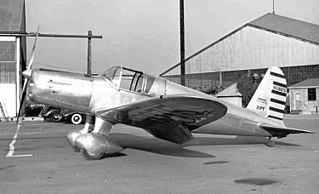
The Kharkiv KhAI-5, was a Soviet reconnaissance and light bomber aircraft, designed in the mid-1930s in the Kharkiv Aviation Institute, under the direction of Iosif Grigorevich Nyeman.

The General Aircraft GAL.56 was a family of 1940s British experimental tailless swept wing glider designs.
The Fairey S.9/30 was a two-seat, single-engined biplane built to meet an Air Ministry specification for a fleet reconnaissance aircraft. It flew during 1934–36 in both land- and seaplane configurations. Although only one was built, it was the progenitor of the Fairey Swordfish.

The Gwinn Aircar was a single-engined biplane with a cabin for two, designed in the US as a safe and simple private aircraft. Lacking a rudder, it had several unusual control features as well as an early tricycle undercarriage. Development was abandoned after a crash in 1938.

The Alpaero Choucas is a French two seat, single engine tailless kit-built ultralight motor glider. At least 12 are flying, with more under construction.
The Nike PUL 9 is an Argentine experimental tailless aircraft powered by a Rotax 447 engine.
The IIL IS-10 was a high-performance, single-seat glider, designed and built in Romania in the early 1960s. It was the first Romanian aircraft to use laminar flow airfoils.
The Gribovsky G-20 was an aerobatic trainer, designed in the USSR in the mid-1930s. Only one was built; re-engined in 1937, it was used to train many aerobatic pilots.
The Gribovsky G-15 was a single engine, side-by-side two seat touring aircraft built in USSR in the 1930s. Only one was completed.

The RRG Storch V was the only member of Alexander Lippisch's Storch series of tailless aircraft to be powered. It flew successfully in the year 1929.
The SEA.1 was a Belgian, multi-purpose, light twin engine monoplane flown in 1936. Only one was built; it was later converted into a single engine aircraft and used by the military.

The Aeroneer 1-B is an all-metal light aircraft built in the United States in 1936. It did not reach production, despite an attempt to interest the USAAC in it as a trainer, but it appeared in three Hollywood films.
The Couzinet 100 was a three-engined, three-seat touring aircraft designed and built in France in 1930. Two variants, the Couzinet 101 and Couzinet 103, were very similar apart from their engines; no variant reached production.

The Dornier Do S was a 22-passenger flying boat airliner flown in Germany in 1930.
The Bodiansky 20, a French four-seat touring aircraft flown in the early 1930s, was one of the first French aircraft to adopt Handley Page slots to delay the stall and lower landing speed.
The unsuccessful French Farman F.200 of 1923 shared its type name with the 1929 Farman F.200, the progenitor of a series of parasol wing tourers. It was a two-seat touring aircraft, with a low, thick, cantilever wing. Only one was built and only briefly tested.
The Invincible D-D was a prototype three/four seat touring aircraft, built in the US in 1929. One example flew but development was ended by the Great Depression.

The Kharkiv KhAI-4 was an experimental Soviet tailless aircraft tested in 1934. It only made three flights before being grounded as dangerous.
The RRG Delta I was a German experimental tailless aircraft flown in the early 1930s first as a glider and then powered. It was one of the first delta wing aircraft.

The Moskalyev SAM-7 Sigma was a one-off, Soviet, experimental tailless fighter aircraft.









